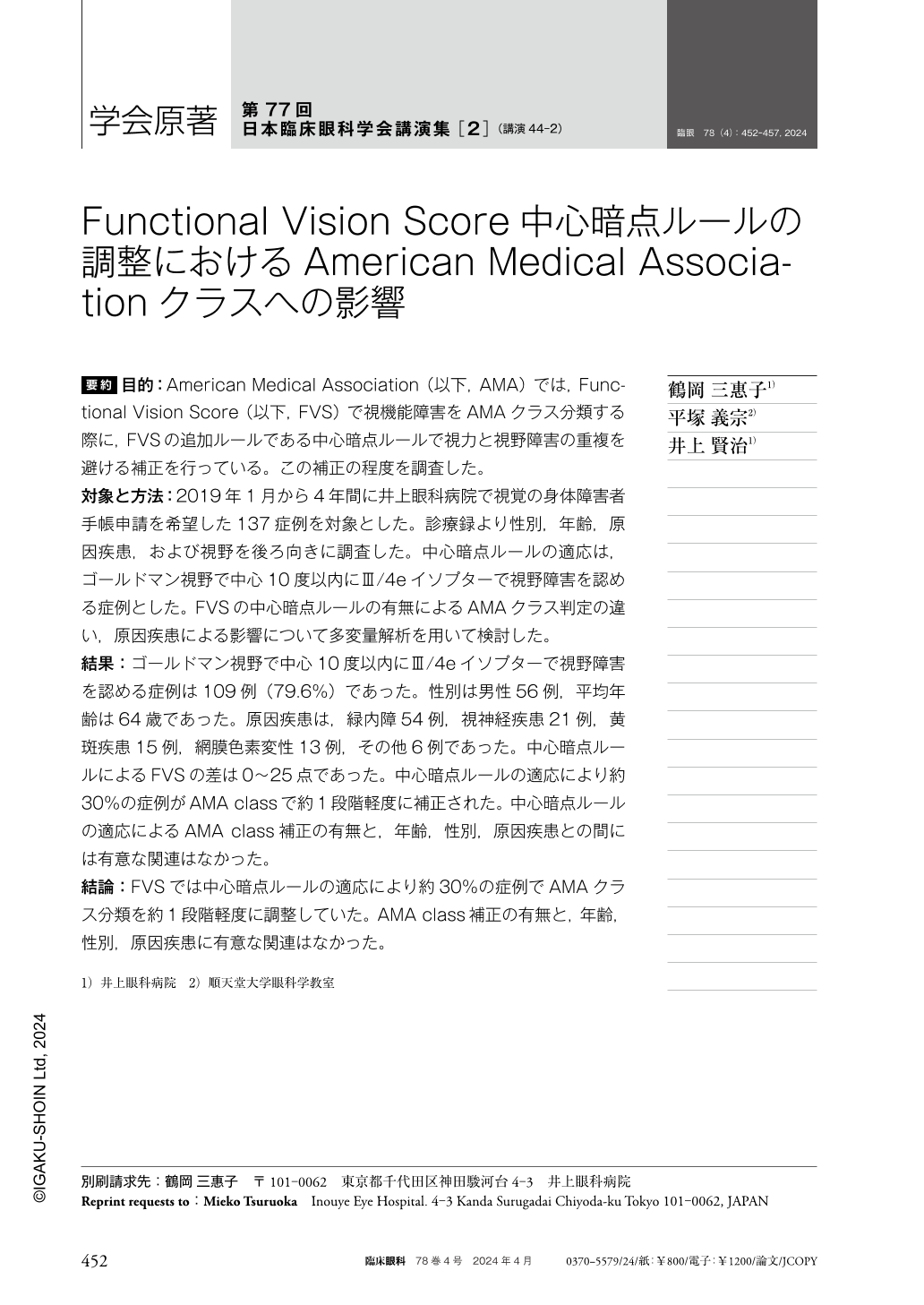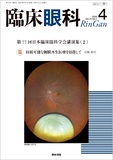Japanese
English
- 有料閲覧
- Abstract 文献概要
- 1ページ目 Look Inside
- 参考文献 Reference
要約 目的:American Medical Association(以下,AMA)では,Functional Vision Score(以下,FVS)で視機能障害をAMAクラス分類する際に,FVSの追加ルールである中心暗点ルールで視力と視野障害の重複を避ける補正を行っている。この補正の程度を調査した。
対象と方法:2019年1月から4年間に井上眼科病院で視覚の身体障害者手帳申請を希望した137症例を対象とした。診療録より性別,年齢,原因疾患,および視野を後ろ向きに調査した。中心暗点ルールの適応は,ゴールドマン視野で中心10度以内にⅢ/4eイソプターで視野障害を認める症例とした。FVSの中心暗点ルールの有無によるAMAクラス判定の違い,原因疾患による影響について多変量解析を用いて検討した。
結果:ゴールドマン視野で中心10度以内にⅢ/4eイソプターで視野障害を認める症例は109例(79.6%)であった。性別は男性56例,平均年齢は64歳であった。原因疾患は,緑内障54例,視神経疾患21例,黄斑疾患15例,網膜色素変性13例,その他6例であった。中心暗点ルールによるFVSの差は0〜25点であった。中心暗点ルールの適応により約30%の症例がAMA classで約1段階軽度に補正された。中心暗点ルールの適応によるAMA class補正の有無と,年齢,性別,原因疾患との間には有意な関連はなかった。
結論:FVSでは中心暗点ルールの適応により約30%の症例でAMAクラス分類を約1段階軽度に調整していた。AMA class補正の有無と,年齢,性別,原因疾患に有意な関連はなかった。
Abstract Purpose:The American Medical Association(AMA)uses the Functional Vision Score(FVS)to classify visual impairment into AMA classes and corrects using the central scotoma rule(rule)to avoid double-counting visual acuity and visual field impairments. This study aimed to investigated the extent of this correction.
Subjects and Methods:This study included 137 patients who applied for visual impairment certificate at Inoue Eye Hospital during a 4-year period from January 2019 were included in the study. Sex, age, causative disease, and visual field were investigated retrospectively from medical records. The rule was indicated for cases with a visual field defect of Ⅲ/4e isopter within 10 degrees of the center in the Goldmann visual field, and the difference in AMA classes with and without the central scotoma rule for the FVS and the influence of causative disease were examined using multivariate analysis.
Results:In total, 109 patients(79.6%)had visual field defect of Ⅲ/4e isopters within 10 degrees of the center in the Goldmann visual field. 56 patients were male, and the mean age was 64 years. Causative diseases were glaucoma(n=54), optic nerve disease(n=21), macular disease(n=15), retinitis pigmentosa(n=12), and others(n=6). The difference in the FVS by rule ranged from 0 to 25 points. Approximately 30% of cases were corrected to one level milder in the AMA class after the central scotoma rule was applied. No significant association was found age, sex, and causative disease with and without AMA class correction by the central scotoma rule.
Conclusion:In the FVS, the application of the central scotoma rule adjusted the AMA class classification to one level milder in Approximately 30% of cases, regardless of age, sex, or causative disease.

Copyright © 2024, Igaku-Shoin Ltd. All rights reserved.


